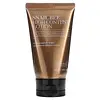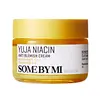What's inside
What's inside
 Key Ingredients
Key Ingredients

 Benefits
Benefits

 Concerns
Concerns

 Ingredients Side-by-side
Ingredients Side-by-side

Butylene Glycol
HumectantGlycerin
HumectantCetyl Ethylhexanoate
EmollientNiacinamide
SmoothingPentylene Glycol
Skin Conditioning1,2-Hexanediol
Skin ConditioningPalmitic Acid
EmollientStearic Acid
CleansingSimmondsia Chinensis Seed Oil
EmollientSorbitan Olivate
EmulsifyingAloe Barbadensis Leaf Juice
Skin ConditioningAlthaea Rosea Root Extract
HumectantAloe Barbadensis Leaf Extract
EmollientBeta-Glucan
Skin ConditioningXanthan Gum
EmulsifyingPanthenol
Skin ConditioningSodium Hyaluronate
HumectantSalix Alba Bark Extract
AstringentPlantago Asiatica Extract
Skin ConditioningLaminaria Digitata Extract
Skin ProtectingDiospyros Kaki Leaf Extract
Skin ProtectingUlmus Campestris Bark Extract
AstringentCaprylyl Glycol
EmollientPolyglyceryl-10 Laurate
Skin ConditioningSnail Secretion Filtrate
Skin ConditioningCetearyl Olivate
Helianthus Annuus Seed Oil
EmollientCitric Acid
BufferingTripeptide-1
Skin ConditioningMyristic Acid
CleansingUsnea Barbata Extract
Glyceryl Stearate
EmollientEthylhexylglycerin
Skin ConditioningPulsatilla Koreana Extract
Skin ConditioningUrea
BufferingHexapeptide-11
Skin ConditioningPalmitoyl Pentapeptide-4
Skin ConditioningBee Venom
AstringentSh-Oligopeptide-1
Skin ConditioningLecithin
EmollientTocopheryl Acetate
AntioxidantCopper Tripeptide-1
Skin ConditioningWater
Skin ConditioningPalmitoyl Tripeptide-1
Skin ConditioningHexapeptide-9
Skin ConditioningPolysorbate 20
EmulsifyingZanthoxylum Piperitum Fruit Extract
Skin ConditioningBehenyl Alcohol
EmollientCarthamus Tinctorius Seed Oil
MaskingLauric Acid
CleansingArgania Spinosa Kernel Oil
EmollientTocopherol
AntioxidantCetearyl Alcohol
EmollientButylene Glycol, Glycerin, Cetyl Ethylhexanoate, Niacinamide, Pentylene Glycol, 1,2-Hexanediol, Palmitic Acid, Stearic Acid, Simmondsia Chinensis Seed Oil, Sorbitan Olivate, Aloe Barbadensis Leaf Juice, Althaea Rosea Root Extract, Aloe Barbadensis Leaf Extract, Beta-Glucan, Xanthan Gum, Panthenol, Sodium Hyaluronate, Salix Alba Bark Extract, Plantago Asiatica Extract, Laminaria Digitata Extract, Diospyros Kaki Leaf Extract, Ulmus Campestris Bark Extract, Caprylyl Glycol, Polyglyceryl-10 Laurate, Snail Secretion Filtrate, Cetearyl Olivate, Helianthus Annuus Seed Oil, Citric Acid, Tripeptide-1, Myristic Acid, Usnea Barbata Extract, Glyceryl Stearate, Ethylhexylglycerin, Pulsatilla Koreana Extract, Urea, Hexapeptide-11, Palmitoyl Pentapeptide-4, Bee Venom, Sh-Oligopeptide-1, Lecithin, Tocopheryl Acetate, Copper Tripeptide-1, Water, Palmitoyl Tripeptide-1, Hexapeptide-9, Polysorbate 20, Zanthoxylum Piperitum Fruit Extract, Behenyl Alcohol, Carthamus Tinctorius Seed Oil, Lauric Acid, Argania Spinosa Kernel Oil, Tocopherol, Cetearyl Alcohol
Citrus Junos Fruit Extract
Skin ConditioningWater
Skin ConditioningButylene Glycol
HumectantNiacinamide
SmoothingGlycerin
HumectantPanthenol
Skin Conditioning1,2-Hexanediol
Skin ConditioningSimmondsia Chinensis Seed Oil
EmollientBenzyl Glycol
SolventBisabolol
MaskingDiphenylsiloxy Phenyl Trimethicone
Skin ConditioningArginine
MaskingCaprylyl Methicone
Skin ConditioningTrehalose
HumectantBehenyl Alcohol
EmollientAcrylates/C10-30 Alkyl Acrylate Crosspolymer
Emulsion StabilisingSodium Acrylate/Sodium Acryloyldimethyl Taurate Copolymer
Emulsion StabilisingCoptis Japonica Root Extract
Skin ConditioningPolyisobutene
Sorbitan Isostearate
EmulsifyingCarbomer
Emulsion StabilisingCentella Asiatica Extract
CleansingDimethicone/Phenyl Vinyl Dimethicone Crosspolymer
Inulin Lauryl Carbamate
Emulsion StabilisingBiota Orientalis Leaf Extract
HumectantTocopherol
AntioxidantStearyl Alcohol
EmollientArachidyl Alcohol
EmollientXylitylglucoside
HumectantEthylhexylglycerin
Skin ConditioningAdenosine
Skin ConditioningAnhydroxylitol
HumectantDisodium EDTA
Xanthan Gum
EmulsifyingZanthoxylum Piperitum Fruit Extract
Skin ConditioningSorbitan Oleate
EmulsifyingCaprylyl/Capryl Glucoside
CleansingXylitol
HumectantPolygonum Cuspidatum Root Extract
AntioxidantRaspberry Ketone
MaskingGlutathione
Biotin
AntiseborrhoeicAscorbyl Glucoside
AntioxidantAscorbyl Tetraisopalmitate
AntioxidantArbutin
AntioxidantMadecassoside
AntioxidantAsiaticoside
AntioxidantMadecassic Acid
Skin ConditioningAsiatic Acid
Skin ConditioningAscorbic Acid
AntioxidantMenadione
MaskingCyanocobalamin
Skin ConditioningCitrus Junos Peel Oil
AstringentLinalool
PerfumingLimonene
PerfumingCitrus Junos Fruit Extract, Water, Butylene Glycol, Niacinamide, Glycerin, Panthenol, 1,2-Hexanediol, Simmondsia Chinensis Seed Oil, Benzyl Glycol, Bisabolol, Diphenylsiloxy Phenyl Trimethicone, Arginine, Caprylyl Methicone, Trehalose, Behenyl Alcohol, Acrylates/C10-30 Alkyl Acrylate Crosspolymer, Sodium Acrylate/Sodium Acryloyldimethyl Taurate Copolymer, Coptis Japonica Root Extract, Polyisobutene, Sorbitan Isostearate, Carbomer, Centella Asiatica Extract, Dimethicone/Phenyl Vinyl Dimethicone Crosspolymer, Inulin Lauryl Carbamate, Biota Orientalis Leaf Extract, Tocopherol, Stearyl Alcohol, Arachidyl Alcohol, Xylitylglucoside, Ethylhexylglycerin, Adenosine, Anhydroxylitol, Disodium EDTA, Xanthan Gum, Zanthoxylum Piperitum Fruit Extract, Sorbitan Oleate, Caprylyl/Capryl Glucoside, Xylitol, Polygonum Cuspidatum Root Extract, Raspberry Ketone, Glutathione, Biotin, Ascorbyl Glucoside, Ascorbyl Tetraisopalmitate, Arbutin, Madecassoside, Asiaticoside, Madecassic Acid, Asiatic Acid, Ascorbic Acid, Menadione, Cyanocobalamin, Citrus Junos Peel Oil, Linalool, Limonene
 Reviews
Reviews

Ingredients Explained
These ingredients are found in both products.
Ingredients higher up in an ingredient list are typically present in a larger amount.
1,2-Hexanediol is a synthetic liquid and another multi-functional powerhouse.
It is a:
- Humectant, drawing moisture into the skin
- Emollient, helping to soften skin
- Solvent, dispersing and stabilizing formulas
- Preservative booster, enhancing the antimicrobial activity of other preservatives
Behenyl Alcohol is a type of fatty alcohol (these are different from the drying, solvent alcohols).
Fatty Alcohols have hydrating properties and are most often used as an emollient or to thicken a product. They are usually derived from natural fats and oils; behenyl alcohol is derived from the fats of vegetable oils.
Emollients help keep your skin soft and hydrated by creating a film that traps moisture in.
In 2000, Behenyl Alcohol was approved by the US as medicine to reduce the duration of cold sores.
Learn more about Behenyl AlcoholButylene Glycol (or BG) is used within cosmetic products for a few different reasons:
Overall, Butylene Glycol is a safe and well-rounded ingredient that works well with other ingredients.
Though this ingredient works well with most skin types, some people with sensitive skin may experience a reaction such as allergic rashes, closed comedones, or itchiness.
Learn more about Butylene GlycolEthylhexylglycerin (we can't pronounce this either) is commonly used as a preservative and skin softener. It is derived from glyceryl.
You might see Ethylhexylglycerin often paired with other preservatives such as phenoxyethanol. Ethylhexylglycerin has been found to increase the effectiveness of these other preservatives.
Glycerin is already naturally found in your skin. It helps moisturize and protect your skin.
A study from 2016 found glycerin to be more effective as a humectant than AHAs and hyaluronic acid.
As a humectant, it helps the skin stay hydrated by pulling moisture to your skin. The low molecular weight of glycerin allows it to pull moisture into the deeper layers of your skin.
Hydrated skin improves your skin barrier; Your skin barrier helps protect against irritants and bacteria.
Glycerin has also been found to have antimicrobial and antiviral properties. Due to these properties, glycerin is often used in wound and burn treatments.
In cosmetics, glycerin is usually derived from plants such as soybean or palm. However, it can also be sourced from animals, such as tallow or animal fat.
This ingredient is organic, colorless, odorless, and non-toxic.
Glycerin is the name for this ingredient in American English. British English uses Glycerol/Glycerine.
Learn more about GlycerinNiacinamide is a multitasking form of vitamin B3 that strengthens the skin barrier, reduces pores and dark spots, regulates oil, and improves signs of aging.
And the best part? It's gentle and well-tolerated by most skin types, including sensitive and reactive skin.
You might have heard of "niacin flush", or the reddening of skin that causes itchiness. Niacinamide has not been found to cause this.
In very rare cases, some individuals may not be able to tolerate niacinamide at all or experience an allergic reaction to it.
If you are experiencing flaking, irritation, and dryness with this ingredient, be sure to double check all your products as this ingredient can be found in all categories of skincare.
When incorporating niacinamide into your routine, look out for concentration amounts. Typically, 5% niacinamide provides benefits such as fading dark spots. However, if you have sensitive skin, it is better to begin with a smaller concentration.
When you apply niacinamide to your skin, your body converts it into nicotinamide adenine dinucleotide (NAD). NAD is an essential coenzyme that is already found in your cells as "fuel" and powers countless biological processes.
In your skin, NAD helps repair cell damage, produce new healthy cells, support collagen production, strengthen the skin barrier, and fight environmental stressors (like UV and pollution).
Our natural NAD levels start to decline with age, leading to slower skin repair, visible aging, and a weaker skin barrier. By providing your skin niacinamide, you're recharging your skin's NAD levels. This leads to stronger, healthier, and younger looking skin.
Another name for vitamin B3 is nicotinamide. This vitamin is water-soluble and our bodies don't store it. We obtain Vitamin B3 from either food or skincare. Meat, fish, wheat, yeast, and leafy greens contain vitamin B3.
The type of niacinamide used in skincare is synthetically created.
Learn more about NiacinamidePanthenol is a common ingredient that helps hydrate and soothe the skin. It is found naturally in our skin and hair.
There are two forms of panthenol: D and L.
D-panthenol is also known as dexpanthenol. Most cosmetics use dexpanthenol or a mixture of D and L-panthenol.
Panthenol is famous due to its ability to go deeper into the skin's layers. Using this ingredient has numerous pros (and no cons):
Like hyaluronic acid, panthenol is a humectant. Humectants are able to bind and hold large amounts of water to keep skin hydrated.
This ingredient works well for wound healing. It works by increasing tissue in the wound and helps close open wounds.
Once oxidized, panthenol converts to pantothenic acid. Panthothenic acid is found in all living cells.
This ingredient is also referred to as pro-vitamin B5.
Learn more about PanthenolThis oil comes from the seeds of the desert shrub called Jojoba. It is more commonly known as jojoba oil, a non-comedogenic oil.
Jojoba oil does not contain fragrance and has many fatty-acids, making it a great soothing ingredient.
It also contains Vitamin E, a great moisturizing ingredient. Vitamin E is also an antioxidant and protects your skin against oxidative damage.
This ingredient humectant properties, meaning it helps draw moisture from the air. This helps keep your skin hydrated.
While jojoba has antibacterial properties, it is only able to kill some strains of bacteria.
Studies also show it helps in wound healing. In fact, Indigenous cultures have used jojoba as a moisturizer and to help treat burns for centuries.
Fun fact: Jojoba oil similar to natural human skin sebum, so it has a great effect on dry skin. It is also promising with helping to regulate sebum production.
Due to its fatty acid content, Jojoba oil may not be fungal acne safe. We recommend speaking with a professional if you have any concerns.
Learn more about Simmondsia Chinensis Seed OilTocopherol (also known as Vitamin E) is a common antioxidant used to help protect the skin from free-radicals and strengthen the skin barrier. It's also fat soluble - this means our skin is great at absorbing it.
Vitamin E also helps keep your natural skin lipids healthy. Your lipid skin barrier naturally consists of lipids, ceramides, and fatty acids. Vitamin E offers extra protection for your skin’s lipid barrier, keeping your skin healthy and nourished.
Another benefit is a bit of UV protection. Vitamin E helps reduce the damage caused by UVB rays. (It should not replace your sunscreen). Combining it with Vitamin C can decrease sunburned cells and hyperpigmentation after UV exposure.
You might have noticed Vitamin E + C often paired together. This is because it is great at stabilizing Vitamin C. Using the two together helps increase the effectiveness of both ingredients.
There are often claims that Vitamin E can reduce/prevent scarring, but these claims haven't been confirmed by scientific research.
Learn more about TocopherolWater. It's the most common cosmetic ingredient of all. You'll usually see it at the top of ingredient lists, meaning that it makes up the largest part of the product.
So why is it so popular? Water most often acts as a solvent - this means that it helps dissolve other ingredients into the formulation.
You'll also recognize water as that liquid we all need to stay alive. If you see this, drink a glass of water. Stay hydrated!
Learn more about WaterXanthan gum is used as a stabilizer and thickener within cosmetic products. It helps give products a sticky, thick feeling - preventing them from being too runny.
On the technical side of things, xanthan gum is a polysaccharide - a combination consisting of multiple sugar molecules bonded together.
Xanthan gum is a pretty common and great ingredient. It is a natural, non-toxic, non-irritating ingredient that is also commonly used in food products.
Learn more about Xanthan GumZanthoxylum Piperitum Fruit Extract comes from the Japanese Pepper, also known as the Prickly Ash. This plant is native to the Korean peninsula and Japan.
The pepper has antioxidant properties. It may help reduce the signs of aging.
For those with fragrance sensitivities, Zanthoxylum Piperitum Fruit Extract contains limonene.
If you have concerns, we recommend speaking with a professional about using this ingredient.
The Japanese Pepper is related to the Sichuan Pepper.
Learn more about Zanthoxylum Piperitum Fruit Extract